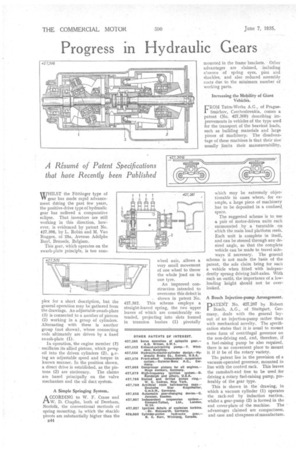Progress in Hydraulic Gears
Page 58

If you've noticed an error in this article please click here to report it so we can fix it.
WHILST the Fottinger type of W gear has made rapid advancement dUring the past few years, the positive-drive type of hydraulic gear has suffered a comparative eclipse. That inventors are still working in this direction, howl ever, is evidenced by patent No. 427,398, by L. Robin and M. Van Roggen, of 25a, Avenue Adolphe Buyl, Brussels, Belgium.
This gear, which operates on the awash-plate principle, is too corn plex for a short description, but the general operation may be gathered from the drawings. An adjustable swash-plate (3) is connected to a number of pistons (2) working in a group of cylinders. Alternating with these is another group (not shown), whose connecting rods ultimately are driven by a fixed swash-plate (1).
In operation, the engine member (r) oscillates its allied pistons, which pi.eop oil into the driven cylinders (2), g.vMg an adjustable speed and torque in known manner. In the position shown, a direct drive is established, as the pistons (2) are stationary. The claims are based principally on the valve mechanism and the oil duct system.
A Simple Springing System,
CCORDING to W. F. Crane and /-1.W. D. Chaplin, both of Dereham, Norfolk, the conventional methods of spring mounting, in which the shackle pivots are substantially higher than the
B44 wheel axis, allows a very small movement of one wheel to throw the whole ;cad on to one tyre.
An improved construction intended to overcome this defect is shown in patent No. 427,352. This scheme employs a straight-leaved spring, the two upper leaves of which are considerably extended, projecting into slots formed in trunnion bushes (1) pivotally mounted in the frame brackets. Other advantages are claimed, including absence of spring eyes, pins and shackles, and also reduced assembly costs due to the minimum number of working parts.
Increasing the Mobility of Giant Vehicles.
CROM Tatra-Werke A.G., of Prague Smichov, Czechoslovakia, comes a patent (No. 427,309) describing improvements in vehicles of the type used for the transport of the heaviest loads, such as building materials and large pieces of machinery. The disadvantage of these machines is that their size usually limits their manceuvrability, which may be extremely objectionable in cases where, for example, a large piece of machinery has to be deposited in a confinett space.
The suggested scheme is to use a pair of motor-driven units each surmounted by a turntable on which the main load platform rests. Each unit is complete in itself, and can be steered through any desired angle, so that the complete vehicle can be made to travel sideways if necessary. The general.
scheme is not made the basis of the patent, the sole claim being for such a vehicle when fitted with indepen dently sprung driving half-axles. With such an outfit, the importance of a low loading height should not be over looked.
A Bosch Injection-pump Arrangement.
DATENT No. 427,287 by Robert 1 Bosch, A.G., of Stuttgart. Germany, deals with the general layout of an injection-pump rather than with mechanical novelty. The specification states that it is usual to mount some form of centrifugal governor on the non-driving end, and, therefore, if a fuel-raising pump be also required, there is no convenient place to mount it if it be of the rotary variety.
The .patent lies in the provision of a vacuum-operated governor, mounted in line with the control rack. This leaves the camshaft-end free to be used for driving a rotary fuel-raising pump, preferably of the gear type.
This is shown in the • drawing, in which a vacuum cylinder (1) operates the rack-rod by induction suction, whilst a gear-pump (2) is formed in the end cover-plate of the machine. The advantages claimed are compactness, and ease and cheapness of manufacture.




























































































